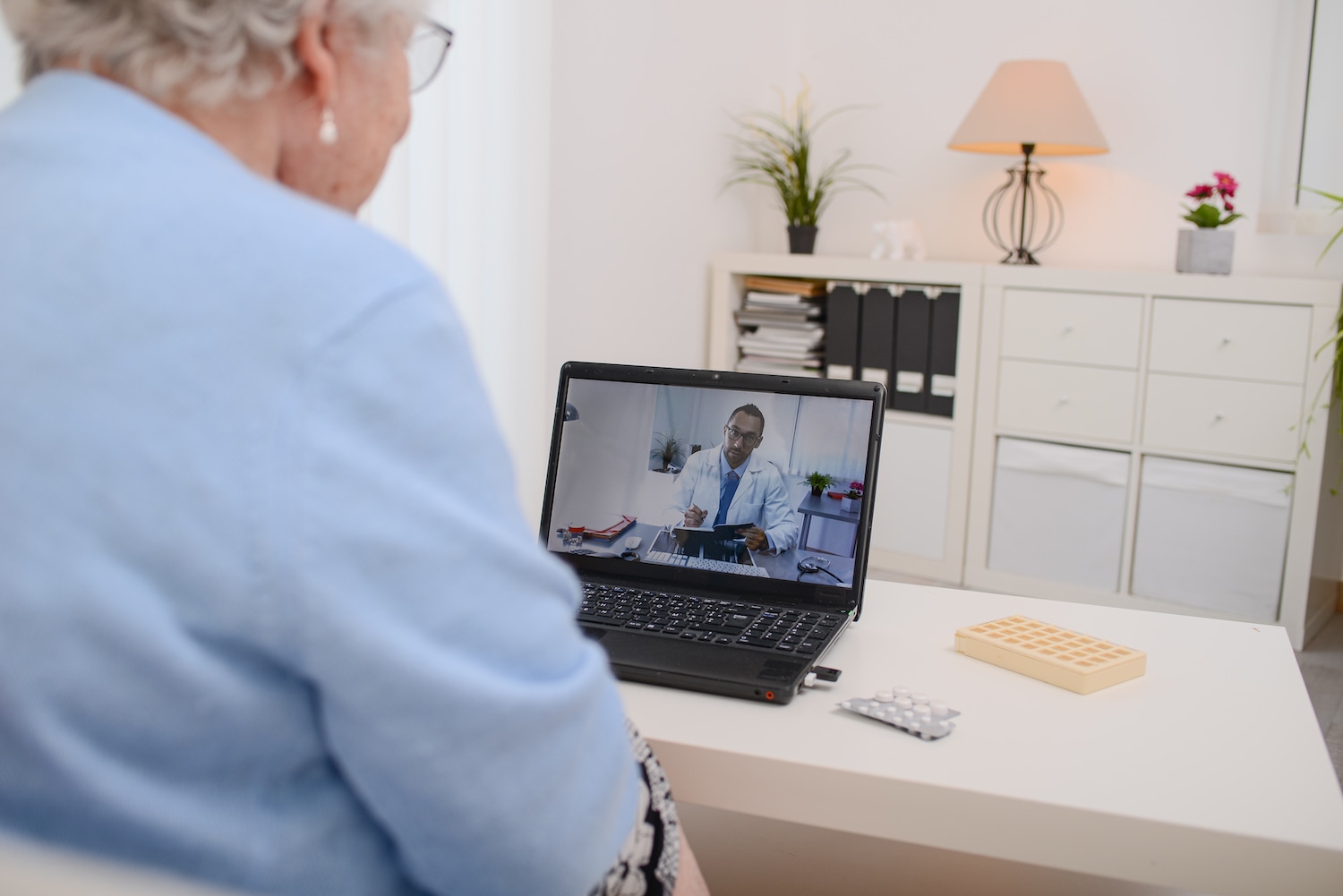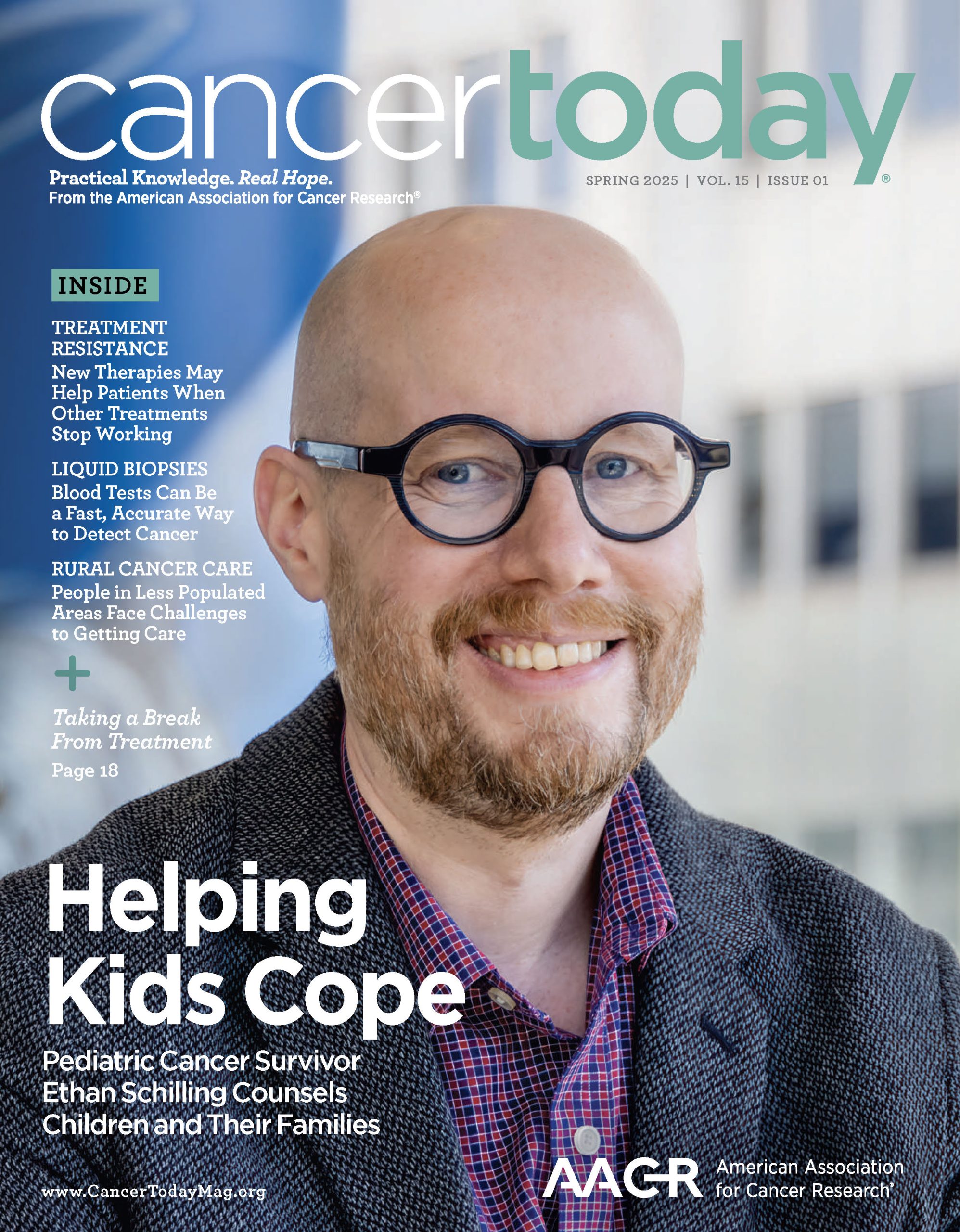In October 2019, a woman living in the New York City area was diagnosed with stage IIIC breast cancer. She began chemotherapy in November 2019 to shrink her cancer prior to a double mastectomy, which was scheduled for March 2020. (She did not want to be referred to by her real name for this article, fearing that an account of her experiences could hurt her treatment quality if her oncologist saw it.)
Around the same time that the woman was establishing her treatment plan and starting her chemotherapy, SARS-CoV-2—the virus that causes COVID-19—began to infect people living in Wuhan, China. As she attended her infusions and prepared her children for her upcoming surgery, the coronavirus began to quietly spread in the U.S. in January or February. Ten days before her surgery, she learned that her operation had been postponed indefinitely as COVID-19 cases began to surge in New York.
Research into how the coronavirus affects cancer patients who get it is ongoing, but data so far indicate that risk of severe COVID-19 cases is elevated in at least some people who have been diagnosed with cancer. In order to reduce risk to patients and staff, cancer centers have tried to minimize the amount of time cancer patients spend hospitalized or in the clinic.
At the same time, in March some hospitals were plunged into a state of shortage or anticipated shortage due to surging COVID-19 cases. In some locations, all but the most urgent surgeries and procedures were halted to protect staff and patients and conserve personal protective equipment, hospital beds and other resources.
For More Information
Read more coverage here from Cancer Today on the various impacts of the coronavirus on people with cancer.
“Things that no one would have considered doing on January 1 became normal practice by April 1,” says Kenneth Rosenzweig, who is chairman of the radiation oncology department at the Mount Sinai School of Medicine in New York City.
After around two weeks of worrying about when her operation would take place, the woman whose surgery was delayed learned about her new surgery date. She received her double mastectomy in April. Around the U.S., cancer centers that slowed surgeries, cancer screening and other procedures are ramping up these services again.
But some impacts of the coronavirus on cancer care will be long-lasting, oncologists say. “We still have to make oncology-centric decisions as our main focus … but we’re constantly and persistently aware of this unseen infectious force that can obviously wreak quite a bit of havoc,” says Joshua Kesterson, a member of the Society of Gynecologic Oncology COVID-19 Task Force and chief of the division of gynecologic oncology at the Penn State Milton S. Hershey Medical Center in Hershey, Pennsylvania.
Delays in Care
On March 13, the American College of Surgeons recommended that hospitals, health systems and surgeons “thoughtfully review” all electively scheduled procedures, with an eye toward minimizing, postponing or canceling them. Within the following week, officials began to restrict elective surgery in their cities and states. Colorectal surgeon Heidi Nelson, who is emeritus chair of the department of surgery at the Mayo Clinic in Rochester, Minnesota, and current medical director of the American College of Surgeons Cancer Programs, explains that elective surgery is surgery you can schedule on a calendar, which can include anything from bunion surgery to removal of a cancer that is partially obstructing the colon. “We never really intended the word elective to be used in this context,” says Nelson, referring to the elective surgery bans.
Nelson and her colleagues quickly developed guidance explaining what types of cancer surgery should still be done in each pandemic phase, depending on availability of resources like personal protective equipment, hospital beds, ICU beds, staffing, and testing and prevalence of COVID-19 in a given area.
The impact of COVID-19 on breast cancer surgery has varied regionally, says Jill Dietz, president of the American Society of Breast Surgeons and a breast surgeon and Director of Breast Operations at University Hospitals Cleveland Medical Center. Dietz was involved in drafting recommendations from the COVID-19 Pandemic Breast Cancer Consortium—a group made up of representatives from multiple cancer care organizations—for treatment of breast cancer patients during the pandemic, as well as considerations for ramping up treatment again.
At some institutions, especially in locations like New York City where COVID-19 was most prevalent, all but the most urgent cancer surgeries were delayed, Dietz says. More cancer surgeries were able to continue at other institutions. Dietz and her colleagues categorized breast cancer patients into priority levels based on the urgency of their care. For instance, many patients with estrogen receptor-positive breast cancer can get hormone therapy in advance of surgery and safely wait for surgery without altering their long-term chances of survival.
Many states lifted elective surgery bans in late April and May. Dietz says that now, many institutions are less worried about personal protective equipment shortages and are operating on breast cancer patients again, with new precautions in place.
Other aspects of cancer care—including follow-up visits, screenings, scans and blood draws, and treatment—have also been impacted. An early survey put out by the American Cancer Society Cancer Action Network (ACS CAN) and completed by more than 1,200 cancer patients and survivors between March 25 and April 8 found that 50% of patients and survivors had experienced a delay, change or disruption to their health care. Among patients undergoing active cancer treatment, 8% reported that their anti-cancer therapy, such as chemotherapy or immunotherapy, had been impacted.
A second ACS CAN survey of more than 1,200 cancer patient and survivors, completed between April 30 and May 14, found that 87% of respondents had experienced some delay, change or disruption to their health care, and 62% had experienced delays, changes or disruptions to care related to their cancer. The survey found that 17% of patients on active cancer treatment had experienced a delay in receiving their treatment.
Rosenzweig, the radiation oncology department chair at Mount Sinai, and his colleagues explained their thinking as they prepared for and worked through the surge in COVID-19 cases in New York City in a paper published May 5 in Advances in Radiation Oncology. Mount Sinai stopped all non-emergent oncologic surgeries in late March and transferred cancer patients who were inpatients in the hospital to outpatient infusion rooms to free up hospital space, the paper reports.
Rosenzweig’s radiation oncology department set out to reduce the number of patients receiving radiation therapy in order to reduce the chance for COVID-19 exposure and also because of concerns that space would be needed as COVID-19 patients increased. “In late March, when some of the projections were most horrifying, we were concerned that every hallway, operating room, linear accelerator room would be used to house patients just because we would need physical space to put them there,” says Rosenzweig. “Thankfully, that never came to pass, but we had to be prepared for that eventuality just in case it did.”
Staffing also has been a concern among some oncologists, due to concerns about illness among staff and possible need to redeploy oncology staff to care for COVID-19 patients. Indeed, a paper published April 6 in Radiotherapy & Oncology tells the story of a single radiation oncology department in Istanbul where 13 out of 18 radiation oncologists tested positive for COVID-19 and five were hospitalized. At Mount Sinai, Rosenzweig’s paper reports, the staff “remained relatively intact.”
Between early March and the beginning of April, Rosenzweig’s department reduced the number of patients receiving radiation therapy by 27% and moved patients to receive treatment at facilities that would not be treating COVID-19 patients. At the lowest volume in mid-April, the department was seeing 40% fewer patients than normal, Rosenzweig says.
Rosenzweig explains that while it was possible to delay treatment for some patients, need for radiation therapy for some cancer types actually increased. For instance, some early-stage lung cancer patients have the option of radiation therapy or surgery, and with surgeries delayed, they increasingly opted for radiation therapy, he explains. Many patients wanted to continue therapy. “A lot of patients can do their own risk assessment, and many of them felt their cancer was more concerning than the risk of COVID,” Rosenzweig says.
Creating a Safer Environment
Even as surgeries return and patients reschedule some postponed visits, COVID-19 remains a threat. But one positive difference, says Nelson, is that hospitals are better prepared now to protect patients and staff. Measures like increased virtual visits, limiting visitors, monitoring the health of staff and keeping patients without COVID-19 separate from patients with COVID-19 are all important, she says.
And patients having surgery or other procedures now are often tested for COVID-19 prior to coming in, even if they have no symptoms of infection, Nelson says. This testing protects staff and other patients in the hospital from infection and also protects patients with asymptomatic COVID-19 from potentially having bad outcomes after undergoing surgery. Representatives from multiple cancer centers also mentioned to Cancer Today that they have instituted testing prior to inpatient hospitalization.
Some institutions are going even further. At Mount Sinai in New York City, for instance, patients receive a COVID-19 test prior to day one of any cycle of chemotherapy or immunotherapy. However, representatives from cancer centers in some other parts of the country told Cancer Today that they are not universally testing prior to initiating chemotherapy or therapy with immune checkpoint inhibitors for now.
Emil Lou, a gastrointestinal oncologist and neuro-oncologist at the University of Minnesota’s Masonic Cancer Center in Minneapolis, notes that a challenge with an ongoing treatment like chemotherapy delivered in an outpatient setting is that a patient could test negative and then later become infected. The Masonic Cancer Center is testing routinely prior to surgery or invasive procedures, but patients are not automatically being tested unless they have symptoms of infection. Lou and co-authors published a paper April 30 in JCO Oncology Practice with recommendations on modifying care for gastrointestinal cancer patients during the pandemic.
David Cohn, the chief medical officer and director of gynecologic cancer research at The Ohio State University Comprehensive Cancer Center (OSUCCC) in Columbus, explains that his institution is testing patients prior to surgeries or other procedures and allowing doctors to use their discretion to decide whether to test a patient prior to chemotherapy. Cohn says that doctors are being told they need to have a plan prior to any testing of asymptomatic patients as to what they would do if the patient tested positive. It is uncertain how long doctors should delay treatment for cancer patients with COVID-19 and when the right choice may be continuing treatment despite the infection.
Going Forward
Beyond new testing regimens, some modifications to cancer treatment continue. “We review the risks and benefits of surgical treatment now versus delay and other therapies with chance of getting COVID,” says breast surgeon Dietz.
Doctors are trying to keep patients out of the hospital when possible. Mary-Elizabeth Percival, an oncology hematologist who focuses on patients with acute myeloid leukemia at the Seattle Cancer Care Alliance and the University of Washington Medical Center, says that some blood cancer patients, for example, are receiving chemotherapy as outpatients that would usually be given in an inpatient setting. Or a treatment that is less likely to lead to hospitalization may be chosen over one that leads to higher hospitalization rates. “These modifications are still ongoing, though we are starting to return to pre-COVID-19 treatment plans in some situations,” Percival says, while emphasizing that regimens have not changed for patients who are being treated with the goal of a cure.
Percival says that the transplant team at her institution is beginning to ramp up transplants to their levels before the pandemic, but she notes that this process will take weeks to months. She and her co-authors explain a variety of situations to consider and possible modifications to blood cancer treatment during the pandemic in a paper published May 5 in JCO Oncology Practice. “For patients with blood cancers, I often say they need to expect the unexpected because there will be twists along the road. … There are so many more twists and turns on the road right now in terms of COVID-19 and how that may affect care going forward that I think [the] expecting the unexpected phrase rings true even more,” Percival says.
For patients receiving outpatient treatments, oncologists are trying to choose regimens that minimize time in the clinic. “From a chemotherapy perspective, the goal has been to minimize risks and maximize safety while still practicing within standards of care,” says Kesterson of Penn State. Measures to reduce exposure to COVID-19 can include getting chemotherapy in a free-standing clinic instead of at an infusion center at a hospital, choosing chemotherapy regimens that require less frequent visits and choosing oral drugs over infused drugs when they are an option. He also says that for ovarian cancer patients, chemotherapy before surgery has been preferred to chemotherapy after surgery, as this allows surgery to be safely delayed and can lead to decreased time in the hospital after surgery when the time comes to operate, since there will be less cancer to remove.
Pelin Cinar, a gastrointestinal oncologist and medical director of quality and safety at the University of California, San Francisco, Helen Diller Family Comprehensive Cancer Center says that a group tasked with surge planning in March worked with pharmacists and oncologists in each disease area to develop a list of all the patients being treated who could safely have their treatment altered to reduce visits. This included modifications like alternative dosing schedules, switching to oral drugs or having infusions at home. Oncologists made decisions individually with each patient on how to proceed, and these modifications continue. The modifications were only made if they would not impact outcomes for patients, she says. Cinar co-authored a paper published April 15 in the Journal of the National Comprehensive Cancer Network outlining methods for protecting cancer patients and staff during the pandemic.
The Food and Drug Administration on April 28 approved the immune checkpoint inhibitor Keytruda (pembrolizumab) to be infused at a double dose every six weeks as an alternative to being infused every three weeks, based on evidence that the drug persists long enough in the body that the longer interval should not affect outcomes.
Within radiation therapy, says radiation oncologist Daniel Spratt of the University of Michigan’s Rogel Cancer Center in Ann Arbor, oncologists are increasingly using shorter schedules of more intense radiation treatments called hypofractionated radiation therapy. “People are trying to deliver shorter courses of radiation where there is reasonable and sufficient evidence to support that,” he says.
Spratt, who focuses on treating genitourinary and central nervous system cancers, also says that treatment for some patients with prostate cancer can safely be delayed for months, noting that many of these patients are elderly and have other health conditions on top of cancer that might increase their risk from COVID-19. Patients with low-risk prostate cancer typically are recommended to undergo active surveillance and may not need treatment for years, says Spratt, who co-authored a paper on recommendations for treating prostate cancer during the pandemic that was published April 1 in Advances in Radiation Oncology.
And doctors say telemedicine is likely here to stay for appointments where no physical examination or treatment is necessary, depending on local rates of COVID-19. “If there’s still a low level of the virus present, I think people are going to be doing everything they can do when possible to increase social distancing, and I think virtual care is kind of the easiest of them to do,” Spratt says.
Kesterson agrees that changes like continued remote visits and mask-wearing will be necessary but says that expressing emotion to patients and communicating with them is harder remotely or while wearing a mask, and no-visitor policies also increase a sense of isolation. “You can appreciate the difficulty in that when you’re, say, seeing a new patient for the first time, that depersonalization,” he says. “This person is going to get chemotherapy or surgery, and in a lot of ways, they’re going to do it by themselves.”
Talking About It
Amid the shifts that have been occurring in cancer care over the past two months, some are concerned that changes—as well as a lack of communication surrounding them—are harming patients.
Cancer survivor Tzvia Bader is chief executive officer and co-founder of TrialJectory, a company that helps match cancer patients with clinical trials. Around March 20, Bader began to get calls from patients who said their cancer treatments were being canceled. TrialJectory sent out a survey and as of mid-April had 80 responses from cancer patients in their database. Of these patients, 35% said that their cancer treatment or testing had been delayed. Bader says that cancer care continues to be delayed in a lot of places, with variation based on location.
One person to reach out was the anonymous woman whose breast cancer surgery was postponed. Although she did ultimately get the surgery, she says that what made the delay so difficult was the period when she did not know what would happen next. She says that she had carefully explained her treatment plan to her family only to be left unsure of how to answer their questions. “They put me in the position that I don’t have answers,” she said in an interview in April the evening before her surgery. She says it was difficult to be alone in the recovery room after surgery, followed by additional emergency surgery. She says she is recovering and doing well now.
Annie Ellis, an ovarian and breast cancer survivor and research advocate living in White Plains, New York, is part of the Society of Gynecologic Oncology COVID-19 Task Force along with Kesterson, and she has provided her perspective as a patient during calls and provided feedback on communications to patients. Ellis says that in March, policies were changing so rapidly that messages weren’t always getting to patients quickly enough. “As cancer survivors, whether we’re on active treatment, whether we’re on maintenance, whether we’re on long-term surveillance, that fear of the cancer getting worse or coming back is always there. It’s just a part of life,” she says. “When you stir in this whole thing with COVID-19, at times we don’t know, are we supposed to be more afraid of the cancer or the virus? … It’s uncertainty on top of uncertainty sprinkled with fear.” Now, she says, patients are adjusting to wearing masks at the clinic, no-visitor policies and telemedicine, but they remain concerned about delays in follow-up care and cancer screenings and staying safe from COVID-19.
Meanwhile, oncologists need to be alert for any decisions that are being made that may harm certain patients disproportionately. “Pandemics create perfect conditions for suboptimal care or deviation from standard care, with major impact on the most vulnerable patients among us, and the reason for that is simple,” said intensivist Louis Voigt of Memorial Sloan Kettering Cancer Center in New York City in a presentation made during the American Association for Cancer Research Virtual Annual Meeting I on April 28. “Health care systems become overwhelmed during crisis situations and during pandemics, and the decisions being made by many health care professionals are sometimes driven by fear and emotions rather than evolving facts.”
For their part, patients should ask questions and push back when they don’t understand why a decision is being made, says Bader. “We should not expect them to have best practices, because it’s a new situation for everyone, but if patients will communicate their concern, will raise their voices and not accept things just as they are, then we can help drive better solutions that everyone will benefit from,” she says.
The Next Wave?
The next group of people oncologists are concerned about is the patients they aren’t seeing.
Jeff Patton is chief executive officer of OneOncology, a national network of community oncology practices. He reported that between April 8 and May 6, OneOncology practices had a 13% decrease in chemotherapy infusions and a 33% decrease in non-chemotherapy visits compared to the prior six months. He says this is partly due to delays in patients with cancer being diagnosed. Visits have also decreased due to practices limiting visits for patients who are not undergoing active cancer therapy, in order to protect patients undergoing treatment from unnecessary risk of exposure to COVID-19.
Routine cancer screening was stopped at many institutions and is now starting up again in some locations. Cohn of OSUCCC says that a slight delay in screening for cancer and diagnosis likely won’t harm patients. His fear, he says, is that patients who were told to delay their screening for six to eight weeks will end up delaying it for six to eight months. “If hospitals are telling you they can have screening tests, it means it’s safe to have the screening test,” he says.
Oncologists also continue to keep their guard up for any future surges in COVID-19 cases. “I listen intently to my role model, Dr. Fauci,” says Lou, explaining that Anthony Fauci, who is director of the National Institute of Allergy and Infectious Diseases, tries to be clear about what he knows and what he doesn’t know. “We all felt we would stay home for a few weeks and then maybe get back to normal. … Here we are two months later where the landscape is different. A lot has happened in just a relatively few weeks, but I think we’re also getting clarity that this isn’t going to go away immediately,” Lou says.
Cohn notes that in recent weeks, a variety of restrictions have lifted in his home state of Ohio. “Our approach at this point in time is kind of wait and see,” he says. OSUCCC is not changing policies on visitors or use of personal protective equipment. The hospital has learned a lot preparing for a surge, he says. It has tightened its supply chain for personal protective equipment and made plan for prioritizing cases if it becomes necessary, for example.
“Because patients with active cancer on active treatment are always more susceptible to infection, it’s really important for patients as well as for the general community just to maintain everything, to keep doing what they’ve been doing in terms of physical distancing and hygiene,” Cohn says.
Nelson says that she hopes that as states and regions are opened up, people realize that this viral infection affects people of all ages, although many will have milder versions. “Whatever you can personally do to help keep this from affecting somebody who is at risk for a [serious or fatal] outcome of COVID, I hope people will do that.”
Cancer Today magazine is free to cancer patients, survivors and caregivers who live in the U.S. Subscribe here to receive four issues per year.





